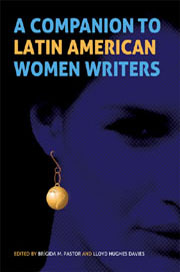Book contents
- Frontmatter
- Contents
- Introduction: The Feminine Voice in Latin American Literature
- 1 Sor Juana Inés de la Cruz (1648/51?–1695)
- 2 Gertrudis Gómez de Avellaneda (1814–1873)
- 3 Gabriela Mistral (1889–1957)
- 4 Alfonsina Storni (1892–1938)
- 5 Silvina Ocampo (1903–1993)
- 6 Clarice Lispector (1920–1977)
- 7 Rosario Castellanos (1925–1974)
- 8 Elena Poniatowska (1933– )
- 9 Alejandra Pizarnik (1936–1972)
- 10 Luisa Valenzuela (1938– )
- 11 Isabel Allende (1942– )
- 12 Rosario Ferré (1938– )
- 13 Laura Esquivel (1950– )
- 14 Laura Restrepo (1950– )
- Conclusion
- Bibliography
- Index
14 - Laura Restrepo (1950– )
Published online by Cambridge University Press: 05 February 2013
- Frontmatter
- Contents
- Introduction: The Feminine Voice in Latin American Literature
- 1 Sor Juana Inés de la Cruz (1648/51?–1695)
- 2 Gertrudis Gómez de Avellaneda (1814–1873)
- 3 Gabriela Mistral (1889–1957)
- 4 Alfonsina Storni (1892–1938)
- 5 Silvina Ocampo (1903–1993)
- 6 Clarice Lispector (1920–1977)
- 7 Rosario Castellanos (1925–1974)
- 8 Elena Poniatowska (1933– )
- 9 Alejandra Pizarnik (1936–1972)
- 10 Luisa Valenzuela (1938– )
- 11 Isabel Allende (1942– )
- 12 Rosario Ferré (1938– )
- 13 Laura Esquivel (1950– )
- 14 Laura Restrepo (1950– )
- Conclusion
- Bibliography
- Index
Summary
Laura Restrepo (Colombia, 1950– ), the author of half a dozen major novels, is fast emerging as one of the leading female writers of Spanish America. The pervasive socio-historical preoccupations of her work might seem to merge almost seamlessly within a body of Spanish American novelistic writing traditionally judged by its social effectiveness. But such a first impression is misleading – at least in part: if there is one common thread running through her diverse literary output it is her consistent blurring of boundaries between traditionally distinct identities, categories and concepts: truth and fiction, historical fact and imaginative re-creation; the sacred and the profane. Temporal and spatial border territories recur in her work: Siete por Tres, the protagonist of La multitud errante (2001) [A Tale of the Dispossessed], is born on 1 January 1950 (on the cusp, therefore, of mid-century) in a rural village located on the border of Huila and Tolima (2001: 25). He is discovered in the church vestibule at the liminal midnight hour. In later life, he engages in a fruitless search for his missing guardian, Matilde Lina, who, as the narrator reflects, ‘se fue al limbo, donde habitan los que no están ni vivos ni muertos’ (2001: 14) [went into limbo, the abode of people who are neither alive nor dead].
- Type
- Chapter
- Information
- A Companion to Latin American Women Writers , pp. 197 - 212Publisher: Boydell & BrewerPrint publication year: 2012



